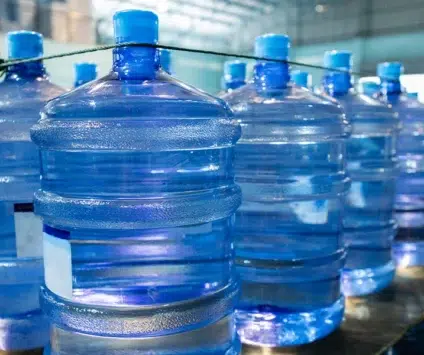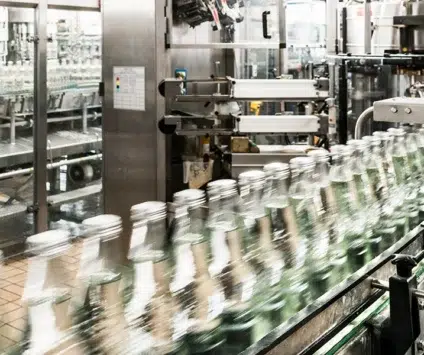
In the bottled water and beverage industry, clean water isn’t just a preference—it’s a necessity. Contaminants in the water supply can affect everything from product taste and safety to the integrity of your bottling equipment. For companies operating at a commercial scale, investing in advanced commercial water treatment systems is essential to maintain consistent product quality, equipment longevity, and regulatory compliance. At Steelhead Inc., we understand the unique challenges faced by bottling operations and the role water purity plays in success, and we are here to help keep your bottling equipment running at the best performance, free from contaminants.
From naturally occurring minerals to microbial threats, each type of contaminant requires a targeted approach for removal. Let’s take a closer look at the most common bottling equipment contaminants and the right commercial water treatment systems to protect your bottling equipment and final product.
1. Hard Water Minerals (Calcium and Magnesium)
The Problem: Hard water contains high concentrations of calcium and magnesium. Over time, these minerals leave scale deposits on pipes, valves, and machinery, reducing efficiency and leading to expensive repairs or replacements.
The Solution: Our commercial water treatment systems, like our mineral injection systems, feed-forward control via flow monitoring to drive high-performance injection pumps, making them ideal components of your bottling equipment. This helps prevent scale buildup and ensures the system runs smoothly, reducing maintenance downtime and extending equipment life.
2. Chlorine and Chloramines
The Problem: While chlorine and chloramines are effective disinfectants in municipal water supplies, they can impact the taste and chemical composition of bottled beverages. These disinfectants can also corrode sensitive components of bottling equipment over time.
The Solution: Activated carbon filtration is one of the most effective methods for removing chlorine and chloramines. Many commercial water treatment systems include pre-filtration stages with high-quality carbon filters specifically designed for this purpose. These filters improve taste and protect your bottling machinery from premature wear.
3. Microorganisms (Bacteria, Viruses, Algae)
The Problem: Pathogens in the water supply pose a serious health risk. If not treated, bacteria, viruses, and algae can contaminate your product, leading to recalls, brand damage, or worse.
The Solution: Our UV Water Purifiers use disinfecting and post-reverse osmosis (RO) system treatments to eliminate microorganisms. UV light disrupts the DNA of pathogens, rendering them harmless, while RO membranes provide a physical barrier that removes even the smallest contaminants. Our modern commercial water treatment systems utilize advanced technologies to ensure that the water used in bottling equipment meets the highest safety standards.
4. Microbial Contaminants and Biofilm
The Problem: Microbial contamination such as bacteria, viruses, and biofilm buildup can occur in water supplies, especially in storage tanks and bottling lines. These contaminants not only pose health risks but can also degrade the performance and cleanliness of your bottling equipment over time.
The Solution: Our Steri Ozone Systems offer a powerful, chemical-free method of disinfection. By injecting ozone—a naturally occurring oxidizer—into the water, these systems neutralize microorganisms and prevent biofilm formation inside tanks, pipes, and other critical parts of the bottling line. Integrated into our commercial water treatment systems, ozone ensures your bottling equipment remains sanitized, efficient, and compliant with health regulations.
5. Organic Compounds and VOCs
The Problem: Volatile Organic Compounds (VOCs) and other organic contaminants can cause off-flavors, strange odors, and chemical reactions within your bottled products.
The Solution: Granular activated carbon and advanced oxidation processes (AOPs) are highly effective at removing organic matter. Integrating these into your commercial water treatment system ensures your product maintains a clean, neutral profile that consumers expect.
Partner With Steelhead Inc.
Water quality significantly impacts product quality, operational efficiency, and brand reputation. Unsatisfactory water quality can lead to contamination and customer dissatisfaction, damaging bottling equipment and increasing operating costs.
A well-designed commercial water treatment system from Steelhead Inc. offers the protection and performance your bottling plant needs. Our systems handle high-volume demands, meet regulatory requirements, and integrate seamlessly with your existing bottling line.
Steelhead Inc. has focused on providing innovative solutions for water treatment and bottling equipment to commercial operations worldwide. Our expert team works closely with clients to design, install, and maintain commercial water treatment systems that deliver clean, reliable water to every part of the bottling process.
If your bottling equipment is underperforming, or you’re experiencing taste inconsistencies, scaling, or frequent maintenance issues, it’s time to take a closer look at your water quality.
Request a quote today or call 800.966.7471 to learn more about our advanced water treatment solutions and how we can help protect your investment—one purified drop at a time.




